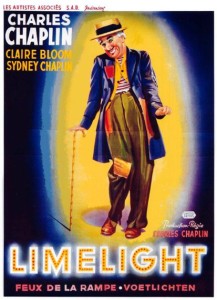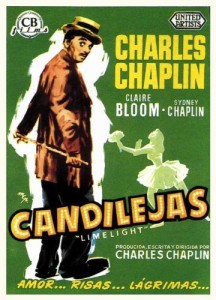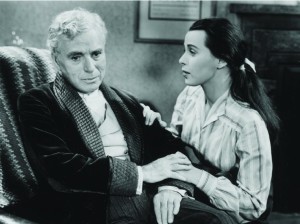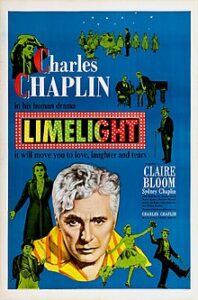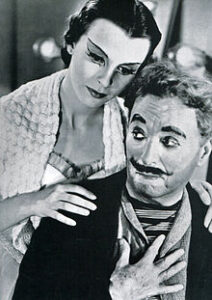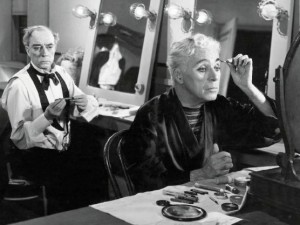Limelight ***** (1952, Charles Chaplin, Claire Bloom, Nigel Bruce, Sydney Chaplin, Buster Keaton, Norman Lloyd) – Classic Movie Review 2549
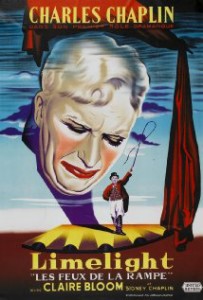
Producer-writer-director-star Charles Chaplin’s 1952 drama with music Limelight is a beautiful film, incredibly poignant, extremely sentimental and nostalgic, but almost unbearably moving both for itself and as an encapsulation of the star’s life. The pairing of Chaplin and fellow silent movie comedy legend Buster Keaton is a great moment in cinema, sharing the limelight.
Their pairing in the final musical number is the only time they performed together on film. Chaplin had not written the part for Keaton because he believed that the role was too small. Later he learned that Keaton was going through hard times and insisted he was cast.
The young Claire Bloom is incredibly lovely and fulfils Chaplin’s faith in her as Thereza, the suicidally despondent ballet dancer who puts the bloom back into fading comedian Calvero (Chaplin)’s cheeks prompting him to stage a final comeback. In the dance scenes, Bloom is doubled by Melissa Hayden.
In his final American film, Chaplin is true to himself to the last and to the spirit of Victorian melodrama. He makes no concessions to the modern world of the Fifties and expects the audience to come to him rather than the other way round. Inspired by the joy of re-creating his early career in the music hall, Chaplin was happy and bursting with creative energy throughout production, but his happiness was soon tested by the film’s hostile reception in the US, or at least his hostile reception.
Chaplin features members of his family in the film, including five of his children and his half-brother Wheeler Dryden. He told his older sons he expected Limelight to be his last film, though it was not.
It also stars Sydney Chaplin, Nigel Bruce and Norman Lloyd. Also in the cast are Andre Eglevsky, Melissa Hayden, Marjorie Bennett, Wheeler Dryden, Barry Bernard, Stapleton Kent, Mollie Glessing, Leonard Mudie, Loyal Underwood, Snub Pollard, Charlie Hall, Sam Harris, Cyril Delevanti, Charley Rogers and Eric Wilson. Edna Purviance, Chaplin‘s favourite co-star from the silent era, makes her final film appearance in a small role.
It is the winner of the 1972 Oscar for Best Original Dramatic Score, the first year of any Los Angeles screening, as Chaplin was being accused of anti-Americanism and communist sympathies in 1952 and the film was heavily boycotted. But 20 years on, it was re-released in the US in 1972, and its first screening in Los Angeles allowed it to enter the 45th Academy Awards when Chaplin won his only competitive Oscar.
After Chaplin sailed to London for the 16 October 1952 world premiere, his re-entry permit to America was revoked because of alleged Communist Party ties. An anti-Chaplin frenzy caused cancellation of showings of Limelight in other cities after screenings in New York and East Coast cities.
Chaplin worked for two and a half years on the screenplay and nine more months on composing the score, arranged by Ray Rasch, resulting in Chaplin’s only competitive Oscar. Chaplin’s theme from Limelight was a hit in the Fifties under the title ‘Eternally’. He said that Calvero is based on the life of stage actor Frank Tinney, not on his father Charles Chaplin Sr as biographers have claimed.
In his autobiography Keaton called Chaplin ‘the greatest silent comedian of all time.’
Bloom, still working (on Midsomer Murders) in 2015, won the 1953 BAFTA Film Award for Most Promising Newcomer to Film (though she had appeared in The Blind Goddess in 1948).
The film was enormously successful in Europe, Japan and around the world but a considerable disappointment in the US, where it was boycotted because of Chaplin’s alleged communist sympathies. It cost $900,000, and earned $7,000,000 outside the US, though only $1,000,000 in the US. As the budget was his own money, and apparently hesitant and indecisive (though creative and energised) on set, Chaplin must have been a happy man.
The film’s 60th anniversary was celebrated by the Academy of Motion Picture Arts and Sciences at the Samuel Goldwyn Theater in Beverly Hills, California, on October 3 2012 with cast members Bloom and Lloyd.
Though set in London, it was shot entirely in the Hollywood, at the Chaplin Studios, Paramount Studios (street where Calvero lives) and at RKO-Pathé Studios in Culver City, California (music hall scenes) over 55 days in October and November 1951. Some exterior scenes use back-projected footage of London.
The version that premiered in London in 1952 runs 141 minutes. After several months, Chaplin deleted a scene in which Calvero leaves the sleeping Thereza, and goes to a bar, where he meets his old friend, arm-less violin player Claudius (Stapleton Kent), who gives Calvero money. This version for worldwide distribution runs 137 minutes. The deleted scene is an extra on the DVD.
Limelight is directed by Charles Chaplin, runs 141 minutes or 137 minutes, is made by Celebrated Productions, is released by United Artists, is written by Charles Chaplin, based on the novella Footlights by Charles Chaplin, is shot in black and white by Karl Struss, is produced by Charles Chaplin, is scored by Charles Chaplin and designed by Eugène Lourié.
Rollie Totheroh worked as cinematographer on Charles Chaplin’s movies for more than 30 years, from the earliest shorts in 1915 via The Kid (1921), The Gold Rush (1925), City Lights (1931), Modern Times (1936) and The Great Dictator (1940) to Monsieur Verdoux (1947).
He was photographic consultant on Limelight. He recalled: ‘The way Chaplin shot the scene over and over, he’d wear out all the actors and actresses. He’d confuse them by doing something so many times and so many different ways, they got so they didn’t know which way they’d done it at any one time. He wore one actress out. Finally she said, “Oh, Mr Chaplin, please tell me what I’m doing wrong and what you want. I’m worn out. I don’t know what to do.” He said, “You’re doing all right, it’s just some little thing I want you to do.”‘
The cast are Charlie Chaplin as Calvero, Claire Bloom as Thereza ‘Terry’ Embrose, Nigel Bruce as Postant, Buster Keaton as Calvero’s partner, Sydney Earl Chaplin as Ernest Neville, Norman Lloyd as Bodalink, André Eglevsky as Male Ballet Dancer, Marjorie Bennett as Mrs Alsop, Wheeler Dryden as Thereza’s doctor and Old Ballet Dancer, Melissa Hayden as Terry’s dance double, Barry Bernard as John Redfern, Stapleton Kent as Claudius (cut for worldwide release), Mollie Glessing as Maid, Leonard Mudie as Calvero’s Doctor, Snub Pollard as Street Musician, Geraldine Chaplin as Little Girl in opening scene, Josephine Chaplin as Child in opening scene, Michael Chaplin as Child in opening scene, Charles Chaplin III as Clown, Cyril Delevanti as Griffin the Clown, Oona O’Neill as Extra, Eric Wilton as Major Domo at Dinner.
© Derek Winnert 2015 Classic Movie Review 2549
Check out more reviews on http://derekwinnert.com


